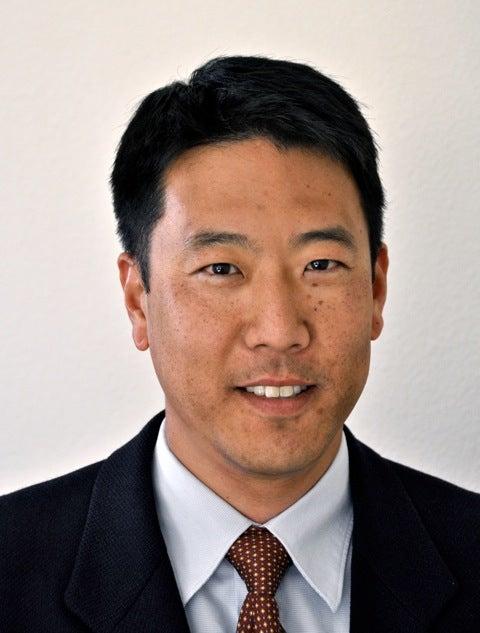Harold Hwang awarded 2024 McGroddy Prize for discovering exotic new materials
The American Physical Society recognized the SLAC and Stanford physicist for decades of groundbreaking work studying the strange behavior of electrons at the interfaces between materials.
By Joe Howlett

The marvels of modern technology – computers that fit in your hand, internet-connected refrigerators, and self-driving cars – are only possible thanks to the magic of materials like silicon. Likewise, the sci-fi gadgets of tomorrow will spring from the exotic new materials scientists are discovering today.
Harold Hwang, a physicist at the Department of Energy's SLAC National Accelerator Laboratory and Stanford University, has brought this future closer by sandwiching carefully crafted materials together and seeing what happens where they touch. His experimentation has uncovered a host of compounds with surprising properties, including a whole new class of superconductors. Now, the American Physical Society has awarded Hwang its 2024 James C. McGroddy Prize for New Materials to celebrate his pioneering research.
The prize recognizes Hwang for “outstanding achievement in the science and application of new materials,” work which spans his decades-long career.
"It's a big honor," Hwang said, and is quick to share credit with his colleagues at the Stanford Institute for Materials and Energy Sciences. “This really represents a whole lot of students, postdocs and collaborators.”
Hwang and his group make super thin sheets of different materials, as little as one molecule thick, and then stack them in different combinations to find out how they behave. “We have a finite number of ingredients across the periodic table,” says Hwang, “and yet it's such a remarkable thing that you put two things together, and you can get anything under the sun.”
Among the things Hwang and his lab focus on is superconductors, which conduct electricity without any resistance or lost energy.
If all electronics were superconductors, our entire power grid could be much more efficient, and new technologies would become possible. But to make a metal into a superconductor, researchers usually need to cool it to roughly the temperature of outer space, which is only possible in specialized lab environments.
In 1986 a family of copper-based materials was discovered that later turned out to superconduct at relatively balmier temperatures, around 200 degrees below zero Fahrenheit, which can be reached by dipping them in liquid nitrogen. No one understands exactly what makes these “unconventional” superconductors work, but their discovery inspired hope that lossless electronics could someday be far more integrated into our daily lives.
In 2019, Hwang and his team of chemical explorers discovered a superconducting blend of nickel and oxygen, breathing new life into these hopes. Since nickel and copper are so similar – they sit side-by-side on the periodic table of elements – scientists have long thought nickel-based superconductors might work at similarly high temperatures. Synthesizing one, however, took decades of trial and error. “There were quite different approaches people took. This is just the first to have success,” says Hwang. “We got lucky.”
Figuring out how unconventional superconductors work might be much easier now that scientists have one more type to study. With such an understanding, researchers aspire to create superconductors that require no coolant at all, which would make the technology far more accessible for everyday applications.
In addition to superconductors, Hwang and his group's material mashups include a method to produce an oxide film on a substrate, then remove the substrate and transfer the film onto any material they want. They also used their oxide-manipulating expertise to design new catalysts that could split water into oxygen and hydrogen, which could help develop new clean ways to store energy.
There's a common theme: Hwang enjoys doing fundamental science that can lead to real-world impact. “What I like is that relatively few people with relatively limited resources have all the ingredients to pursue an idea, try to make a realization of that idea, and feed it back into our daily life.”
Contact
For questions or comments, contact the SLAC Office of Communications at communications@slac.stanford.edu.
About SLAC
SLAC National Accelerator Laboratory explores how the universe works at the biggest, smallest and fastest scales and invents powerful tools used by researchers around the globe. As world leaders in ultrafast science and bold explorers of the physics of the universe, we forge new ground in understanding our origins and building a healthier and more sustainable future. Our discovery and innovation help develop new materials and chemical processes and open unprecedented views of the cosmos and life’s most delicate machinery. Building on more than 60 years of visionary research, we help shape the future by advancing areas such as quantum technology, scientific computing and the development of next-generation accelerators.
SLAC is operated by Stanford University for the U.S. Department of Energy’s Office of Science. The Office of Science is the single largest supporter of basic research in the physical sciences in the United States and is working to address some of the most pressing challenges of our time.





